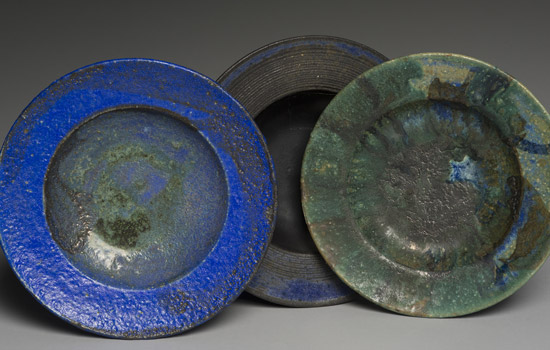Glazed Treasures: Frans Wildenhain Ceramic Exhibition at RIT Aug. 20-Oct. 2
Bauhaus-trained artist and educator was mid-century studio pottery innovator
A. Sue Weisler
Pottery by renowned ceramicist Frans Wildenhain.
Children make mud pies—but grown-ups form clay, sand and water into works of art.
Frans Wildenhain creatively transformed clay beyond simple vessels, elevating the medium to the status of art. In 1950, the internationally renowned Bauhaus-trained ceramicist helped launch the School for American Craftsmen at Rochester Institute of Technology where he taught for two decades. Today it is known as the School for American Crafts.
More than 150 pieces of his work are showcased in an exhibition, Frans Wildenhain 1950-75: Creative and Commercial American Ceramics at Mid-Century, from Aug. 20 through Oct. 2. In a first-time cross-gallery collaboration, the show runs simultaneously at two venues on RIT’s Henrietta campus—Bevier Gallery and National Technical Institute for the Deaf’s Dyer Arts Center.
“The years following World War II saw an explosion and revolution in ceramics as an art form,” says Bruce Austin, RIT professor and organizer of the Wildenhain exhibit. “Nimble artists in one-person studios manipulated clay, changing pottery from a utilitarian or industrial commodity to an art that celebrates the medium as much as its expression.”
In addition to teaching countless students at RIT, many who achieved international reputations for their artistry, Wildenhain was a business innovator. In 1953, the ceramicist and three colleagues opened a retail store named Shop One in downtown Rochester. The artists’ cooperative—a novel and bold venture—was one of two retail venues in the U.S. to offer only handcrafted art.
The Wildenhain exhibition draws from a single owner’s collection initiated in 1955 with purchases made at Shop One. Robert Bradley Johnson, an Eastman Kodak retiree, says he was “bitten by the collector’s disease and couldn’t stop buying Wildenhain’s pots.”
In 2010, Johnson donated more than 330 pieces—from small vessels to large sculptural works—to the RIT Archive Collection. “Perfection is dull and what I treasured most about Wildenhain’s pottery were the irregularities—how his fingers could mold clay into something that lives and breathes life,” Johnson says.
Wildenhain received his artistic training in the early 1920s at the Bauhaus pottery workshop in Weimar, Germany. He emigrated to the U.S. in 1947, joining his wife in Guerneville, Calif., at an artist’s commune modeled on the Bauhaus. He was recruited to RIT by Harold Brennan, dean of the College of Fine and Applied Arts. Brennan had seen a small exhibit of Wildenhain’s work at the Art Institute of Chicago and correctly predicted Wildenhain would ensure the school’s future.
An accompanying catalogue, Frans Wildenhain 1950-75: Creative and Commercial American Ceramics at Mid-Century, is comprised of scholarly essays, archival images and color photographs of the objects on display. The text includes Wildenhain’s biography, a history of RIT’s School for American Craftsmen, contextualization of Wildenhain’s art within mid-century modern U.S. ceramics, an investigation of the commercialization of crafts at Shop One, and an interview with collector Johnson.
The Wildenhain exhibit is a thematic extension of Austin’s previous exhibit, “The Arts & Crafts Movement in Western New York, 1900-1920.” Wildenhain advances the time frame, focusing on a single artist, to explore creative and commercial dimensions of artistic innovation.
For more information about the Frans Wildenhain exhibition, contact Austin at 585-475-2879 or go to the Frans Wildenhain website.
 Pottery by renowned ceramicist Frans Wildenhain, which will be on view during an exhibition from Aug. 20–Oct. 2 at RIT. A. Sue Weisler
Pottery by renowned ceramicist Frans Wildenhain, which will be on view during an exhibition from Aug. 20–Oct. 2 at RIT. A. Sue Weisler














